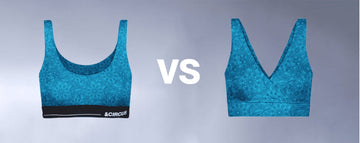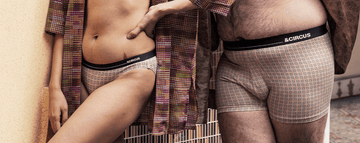Picture this: you slip into a pair of underwear so soft it feels like a whisper against your skin, yet it's made from sustainable fibers that leave the planet smiling. This isn't a fantasy it's the new frontier of innerwear, where comfort meets conscience. As consumers demand more from their clothing, fabric softness has become a quiet revolution, reshaping how we think about what's closest to our skin. Digital platforms, from TikTok to fashion blogs, are buzzing with creators dissecting the tactile allure of these fabrics, while brands race to innovate. But what's driving this obsession with softness, and why does it matter?
Uncomfortable underwear shouldn't steal your confidence. At Andcircus, we craft ultra-soft, sustainable Lenzing Modal Micro® innerwear for every body, XS to 5XL. From briefs to bras, our custom packs fit you perfectly. Shop risk-free with our 100% satisfaction guarantee and embrace comfort that includes everyone. #LoveEveryBody. Shop Now!
Channels Explore Innovations in Fabric Feel
The quest for the ultimate soft touch in innerwear isn't just about indulgence it's a response to a growing consumer hunger for sustainability without sacrifice. According to a report from Precedence Research, the global fabric softener sheet market, valued at USD 21.37 billion in 2024, is projected to hit USD 32.84 billion by 2034, growing at a CAGR of 4.39% from 2025 to 2034. This surge is fueled by a rising interest in eco-friendly options, with North America holding a commanding 39% revenue share in 2024. Meanwhile, Asia-Pacific is sprinting ahead as the fastest-growing region, reflecting a global shift toward sustainable fabric care. Innerwear brands are listening, weaving this demand into their designs with fibers that feel as good as they perform.
Softness isn't just a luxury it's a language. Consumers are no longer content with scratchy synthetics or stiff cottons; they want fabrics that caress, breathe, and align with their values. This is where digital media steps in, amplifying the conversation. From YouTube reviewers to Instagram influencers, content creators are turning fabric softness into a viral sensation, showcasing why it's become a cornerstone of sustainable fashion.
The Science of Silky: New Fibers, New Feels
Behind the scenes, textile innovation is rewriting the rules of comfort. Plant-based fibers like micromodal, bamboo, and TENCEL™ are stealing the spotlight, offering a buttery softness that rivals traditional materials while boasting eco-friendly credentials. These regenerated fibers, derived from sustainable sources like wood pulp, aren't just soft they're breathable, moisture-wicking, and durable. Add to that advanced knitting techniques that create smoother finishes, and you've got fabrics that feel like a second skin.
Textile engineers are also tapping into AI to design fabrics that optimize softness without compromising strength. Imagine a pair of underwear that feels like a cloud but holds up through countless washes. This isn't sci-fi it's happening now. A report from GrandView Research notes that the global fabric softener and conditioner market, valued at USD 14.59 billion in 2023, is expected to reach USD 18.35 billion by 2030, growing at a CAGR of 3.4%. The liquid segment, which often enhances the softness of these innovative fabrics, held a 55.5% market share in 2023, with Asia-Pacific leading at 38.3%. These numbers underscore a clear trend: consumers want fabrics that feel good and do good.
From TikTok to Touch Tests: The Creator Economy Weighs In
Scroll through TikTok, and you'll find creators running “touch test” challenges, rubbing fabrics against their cheeks or stretching them to show off their silky give. These short, tactile demos are more than just viral fodder they're shaping how consumers perceive softness. YouTube reviewers dive deeper, comparing brands side by side, while fashion blogs and sustainability forums break down the science behind fibers like bamboo versus micromodal. These platforms aren't just reviewing products; they're setting benchmarks for what softness should feel like.
Consumer feedback is also evolving. Wear-test panels and tactile metrics, often shared through unboxing videos or detailed blog posts, give shoppers a virtual feel for fabrics before they buy. It's a new kind of storytelling one that bridges the gap between digital screens and sensory experience. As one influencer put it, “Softness isn't just a feature; it's a feeling you can't fake.”
Brands Betting Big on Softness
Sustainable innerwear brands are leaning hard into this trend. Take one label that switched to micromodal a wood-pulp-derived fiber known for its featherlight touch. The result? A spike in customer retention and glowing reviews praising the fabric's next-level comfort. These brands aren't just selling underwear; they're selling an experience. Certifications like OEKO-TEX®, which ensure fabrics are free of harmful substances, add credibility to their softness claims, turning skeptics into loyalists.
Marketing campaigns are getting creative, too. Unboxing videos that capture the sensory thrill of soft fabrics are driving engagement, while brands use 3D fabric mapping to visualize texture online. It's a smart move: according to Lucintel, the fabric softener and conditioner market is projected to grow at a CAGR of 3.9% from 2025 to 2031, with commercial applications leading the charge. North America is expected to see the highest growth, as brands double down on premium, soft-to-the-touch products that resonate with eco-conscious shoppers.
The Softness Challenge: Perception vs. Reality
Here's the catch: softness is subjective. What feels luxurious to one person might feel flimsy to another. Skin types, climates, and personal preferences all play a role, making it tough for brands to nail a universal standard. Digital platforms face their own hurdle how do you convey a tactile sensation through a screen? Videos and photos can hint at softness, but they can't replicate the real thing.
Then there's the cost. Sourcing sustainable, ultra-soft fibers like TENCEL™ or micromodal isn't cheap, and scaling production without cutting corners is a balancing act. Some brands fall into the trap of overhyped claims, touting “cloud-like softness” that doesn't hold up in wear tests. Third-party validations, like those from OEKO-TEX®, are helping separate genuine innovators from the noise, but the industry still has work to do.
Softness as Strategy: The Business Payoff
For sustainable innerwear brands, softness isn't just a selling point it's a competitive edge. By positioning it as a premium feature, they're tapping into a market willing to pay more for comfort that aligns with their values. Data-driven personalization is also emerging, with brands using customer feedback to tailor softness levels to individual needs. Imagine a quiz that matches you to the perfect fabric based on your skin sensitivity or climate some brands are already experimenting with this.
Reducing return rates is another win. By investing in 3D visualization and creator partnerships, brands are helping shoppers “feel” fabrics virtually, cutting down on the “it's not as soft as I expected” returns. Collaborations with influencers are setting new softness benchmarks, turning tactile quality into a measurable standard.
A Softer Future Awaits
Industry experts see softness as more than a trend it's a new standard for sustainable fashion. Imagine smart fabrics that adjust their texture based on your body temperature or movement, or innerwear that feels softer with every wash. These innovations are on the horizon, driven by advances in textile engineering and consumer demand for eco-friendly comfort. For brands, the path forward is clear: invest in R&D, lean on third-party certifications, and tell transparent stories that connect with shoppers.
Softness isn't just a sensory perk anymore it's a strategic pillar. As digital creators amplify the conversation and consumers vote with their wallets, the innerwear industry is proving that feeling good can also mean doing good. Next time you slip into a pair of impossibly soft underwear, know that it's more than just fabric it's a revolution, one gentle touch at a time.
Frequently Asked Questions
What recent advancements are being made in fabric softness technology?
Innovations in fiber blending, enzymatic finishing, and sustainable softeners are enhancing fabric softness without compromising durability or eco-friendliness. These developments aim to deliver a premium feel while meeting rising consumer expectations for comfort and sustainability.
How do sustainable practices affect the softness of fabrics?
Eco-conscious manufacturing methods now incorporate natural enzymes and plant-based softeners to improve hand-feel while reducing harmful chemicals. These techniques allow fabrics to remain soft and breathable without sacrificing environmental responsibility.
Why is fabric softness important in modern innerwear and apparel?
Softness is a key comfort factor in everyday wear, especially in intimate and loungewear garments. Consumers increasingly associate softness with quality and skin-friendliness, prompting brands to prioritize tactile appeal in their material choices.
Disclaimer: The above helpful resources content contains personal opinions and experiences. The information provided is for general knowledge and does not constitute professional advice.
You may also be interested in: The Importance of Moisture-Wicking Underwear in Tropical Cities
Uncomfortable underwear shouldn't steal your confidence. At Andcircus, we craft ultra-soft, sustainable Lenzing Modal Micro® innerwear for every body, XS to 5XL. From briefs to bras, our custom packs fit you perfectly. Shop risk-free with our 100% satisfaction guarantee and embrace comfort that includes everyone. #LoveEveryBody. Shop Now!







































